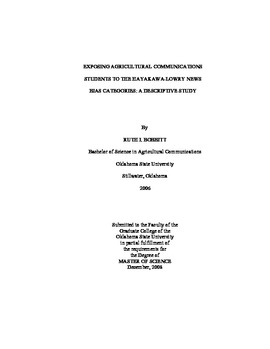| dc.contributor.advisor | Sitton, Shelly R. | |
| dc.contributor.author | Bobbitt, Ruth I. | |
| dc.date.accessioned | 2014-04-15T20:07:23Z | |
| dc.date.available | 2014-04-15T20:07:23Z | |
| dc.date.issued | 2008-12-01 | |
| dc.identifier.uri | https://hdl.handle.net/11244/8745 | |
| dc.description.abstract | This study employed the Hayakawa-Lowry content analysis methodology (Lowry, 1985) and a researcher-designed survey instrument to answer the eight research questions presented in the study. The population for this study consisted of agricultural communications students enrolled in AGCM 3113: Writing for Agricultural Publications during the spring 2008 semester at Oklahoma State University (N = 17). The study was designed to collect census data from the population; thus, no sampling was required. Ten students chose to participate in the study. Therefore, the target population was N = 10. The 10 students participating in the study did not become more objective writers after attending a lecture and receiving a handout about the Hayakawa-Lowry news bias categories. However, participants used a variety of sentence types when writing news articles, and the news writing of students participating in the study fulfilled the objectivity; standard of the social responsibility theory of the press because, overall, participants' news writing assignments were more objective than judgmental. When participants used judgment statements, they tended to write from a more favorable than unfavorable standpoint. After the students attended a lecture and received a handout about the Hayakawa-Lowry news bias categories, the students' news writing became significantly more balanced. Student perceptions of the objectivity level and their use of judgment statements did not change significantly. Perceptions of their use of judgment statements matched their use of judgment statements as measured by the Hayakawa-Lowry methodology. Before students attended a lecture and received a handout about the Hayakawa-Lowry news bias categories, student perceptions of the objectivity level of their news writing did not match the objectivity level of their writing as measured by the Hayakawa-Lowry methodology. The objectivity level of their writing was significantly lower than student perceptions of the objectivity level of their writing. However, after the students attended a lecture and received a handout about the Hayakawa-Lowry news bias categories, student perceptions of the objectivity level of their news writing did match the objectivity level of their writing. | |
| dc.format | application/pdf | |
| dc.language | en_US | |
| dc.publisher | Oklahoma State University | |
| dc.rights | Copyright is held by the author who has granted the Oklahoma State University Library the non-exclusive right to share this material in its institutional repository. Contact Digital Library Services at lib-dls@okstate.edu or 405-744-9161 for the permission policy on the use, reproduction or distribution of this material. | |
| dc.title | Exposing Agricultural Communications Students to the Hayakawa-Lowry News Bias Categories: A Descriptive Study | |
| dc.type | text | |
| dc.contributor.committeeMember | Cartmell, Dwayne | |
| dc.contributor.committeeMember | Blackwell, Cindy Southard | |
| osu.filename | Bobbitt_okstate_0664M_10144.pdf | |
| osu.college | Agricultural Sciences and Natural Resources | |
| osu.accesstype | Open Access | |
| dc.description.department | Department of Agricultural Education, Communications, and Leadership | |
| dc.type.genre | Thesis | |
